Rook Game Variations Unleashed: Fresh Twists to Keep Every Game Exciting!
The Complete Guide to All Rook Games
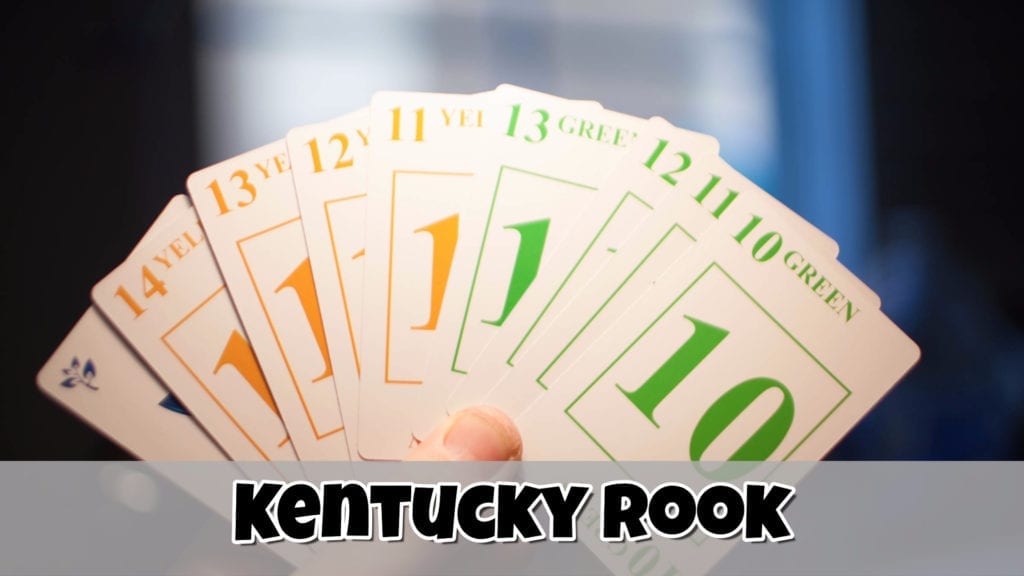
Kentucky Rook
Setup
First you need a standard 57 Card Deck. You then take out the 1s 2s 3s and 4s from the deck, the dealer shuffles and cuts the deck. Finally the dealer deals the cards so that everyone has 9 cards and there are 5 cards in the middle of the board. These 5 cards in the middle are called the nest.
Bidding
After the deal the players bid for the privilege of using the cards in the nest and naming the trump suit. The bidding starts with the person to the left of the dealer and passes around clockwise. The minimum bid is 100 and all bids must be increased by multiples of 5. If a player chooses not to increase the bid the bidding passes to the next player. Once a player passes they may not bid for the remainder of the round. Once all, but 1 of the players have passed the player with the highest bid gets to pick up the nest. Then they put any 5 cards back into the nest. They then name the trump suit.
Play
Once the trump suit is been named the play starts with the person to the left of the dealer. That person can play any card face up on the center of the table. The play goes clockwise around the table. Each player may either play a card with the same suit as the first card, or the wild 57th card. If a player reneges, or fails to play the same suit when he or she could have, the error may be corrected in the next play. If it is not discovered until later, the round ends, and the team that made the error loses a number of points equal to the bid, regardless of which team made the bid. The opposing team scores all the counters they captured before the error was discovered.choose to play a card of the trump suit. Finally after each play the person who played the highest card from the trump suit, or if no trump suit cards where played, the highest card from the initial suit wins that set. They get to take the cards and put them face down in front of them. PS the wild 57th card is the highest possible card so if it is played the player wins the cards automatically.
Scoring
When all rounds have been played each team adds up the value of the cards it won. If the bidding team does not get at least the bid that they made then they will lose points equal to the amount of the bid. The first team to reach 300 points wins.
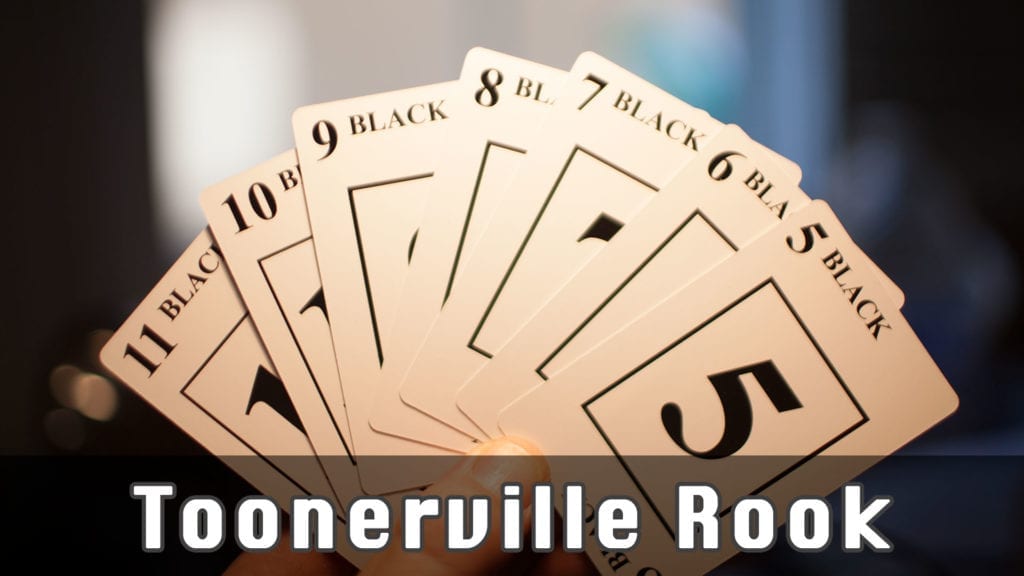
Toonerville Rook
Objective
To have the lowest score at the end of the game. This is achieved by discarding your cards onto the play field and as few points against you as possible (which are left in your hand when someone wins the round).
Number of players
Three to five players per table. You can play tournament style in groups of three to five people. At the end of each round, move to another seat. Keep a master score sheet to record everyone’s score as in single table Toonerville Rook.
Materials
One deck of 57 Cards per person at the table. All decks are shuffled together so if you are sharing decks. Usually, the host provides a set of cards; four or five decks that can be used for play by everyone at the table.
Runs
A run is four or more cards of the same color (suit) in sequential order. “Wrap around” (13, 14, 1, 2, for example) is not allowed.
Sets
A set is three or more cards of the same number (and can be any combination of colors).
The 57 Card
The 57 card is a wild card. If the 57 card is in a run on the play field, a player, during his turn may substitute the card that the 57 card represents, taking the 57 card and using it to play in his own hand. However, whenever a 57 card is taken in this fashion, it must be played during the player’s turn. Note: Only cards that are in runs may be substituted. Cards in sets may not be substituted.
A Player’s Turn
At the beginning of a player’s turn, a player must draw one card from either the deck or the discard pile. At the end of a player’s turn a player must discard one card onto the discard pile, except when ending a round. (At the end of Round 11, a player must not discard when ending the round.) A player may not pick up from the discard pile and discard that same card.
At the beginning of a player’s turn, if the player does not want the top card of the discard pile, the other players have the option to buy that card before the player draws a card from the deck.
Buying a Card
An opponent states that he wants the card on top of the discard pile by saying “I’ll buy that!” If more than one opponent wants to buy the card, the buyer closest to the player’s left receives the card. The player buying the card draws an additional card from the deck (two cards total). Then play resumes with the player whose turn it is drawing his card from the deck. After a card is bought in a turn, the player whose turn it is may not then draw from the discard pile and must draw from the deck.
Playing a Round
A player must obtain the specified number of runs and sets for any given round and play them on their field. When to play your cards is a matter of strategy.
A player may play cards on an opponent’s play field if
- the player has played on his own play field with the required number of runs and sets for that round and
- the card played on an opponent’s play field follows the rules for runs and sets.
Since play field points are not awarded, playing cards on an opponent’s play field is simply a way of ridding your hand of extra cards.
When a player plays his last card on the field or discards his last card on the discard pile the round is over. Cards left in opponent’s hands are tallied up and recorded. The player who plays his last card receives zero points.
Round 11 differs from the other rounds in that you must not discard at the end of the round. In other words, the card that you draw at the beginning of your turn must fit into the two runs and two sets you have been gathering so that you can lay your whole hand down at once. So take care in the amount of buying you do in Round 11.
Rounds
- Two sets (deal 12 cards)
- One run and one set (deal 12 cards)
- Two runs (deal 12 cards)
- Three sets (deal 12 cards)
- One run and two sets (deal 12 cards)
- Two runs and one set (deal 12 cards)
- Four sets (deal 12 cards)
- Three runs (dea1 12 cards)
- Five sets (deal 15 cards)
- Four runs (deal 16 cards)
- Two runs and two sets (no discard at the end of the round) (deal 12 cards)
Scoring
- Cards 1 through 9 are 5 points each
- Cards 10 through 14 are 10 points each
- Rook cards are 25 points each
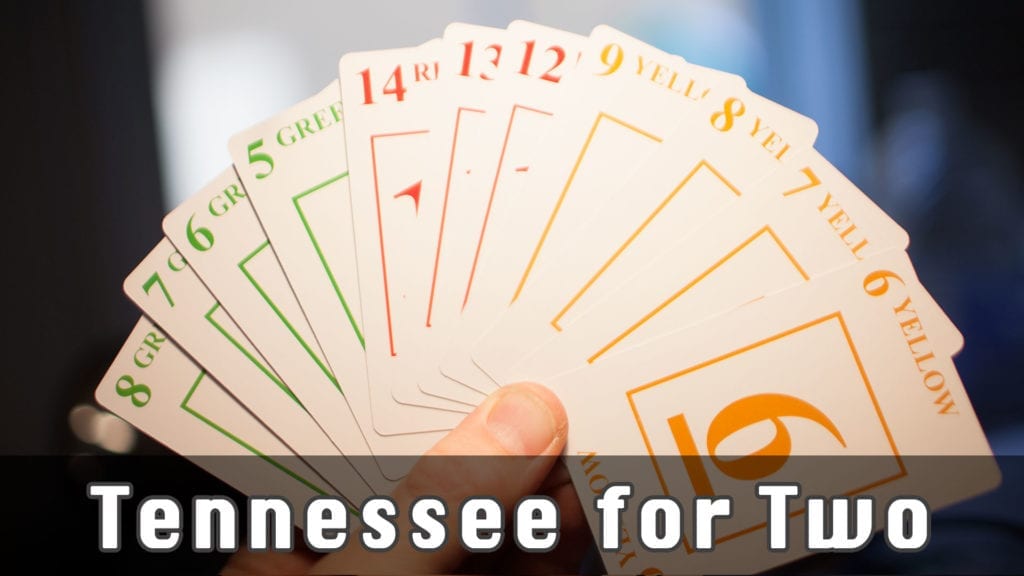
Tennessee for Two
1. Remove all the cards numbered 1, 2, and 3 of each color from the deck, leaving 44 cards.
2. DEALING: To choose dealer, plyers draw for high card. The dealer shuffles the pack thoroughly. He deals cards one at a time, until each player has 11 cards. Next he deals 4 cards face down to the center of the table to form the nest.
3. DRAWING PILE: Place remainder of deck face down on the table to the left of the dealer, halfway between players. This is the drawing pile. Pick the top card from the pile, turn it face up and place it next to the drawing pile.
4. BIDDING: Bide for privilege of naming trump color as in regular 57 card game. Dealer must begin by bidding 60 or over. The highest bidder names the trump color and then picks up the nest. He may exchange any of the cards in the nest for cards in his hand. If, however, thereare any Count Cards – 5’s, 10’s, 14’s – in the nest, he must take them in exchange and is not allowed to discard a Count Card to the nest, since all Count Cards must be used in the game. The nest is then removed from the game.
5. PLAY: The low bidder leads by playing a card from his own hand. High bidder then follows. The higher card takes the trick of 2 cards thus played. A player must always follow the color led if possible. If he cannot do so, he may play a trump card or any card he does not want. A player may lead trumps or any color of his choice.
6. AFTER EACH TRICK IS CAPTURED: That player who captured a trick draws one card from the drawing pile and adds it to the other cards in his hand. He has his choice of drawing the top card from the drawing pile or the exposed card alongside it. The other player must draw one of these two cards not used at that turn by his appoinent. That player who captures the trick leads for the next trick. Players continue to draw, and take tricks until the drawing pile is exhausted. Thereafter each player will be left with 11 cards, and play continues as before without use of the drawing pile.
7. SCORING: 250 points win the game. Count Cards score as in the regular 57 cards game. Each 14 counts 10, each 10 counts 10, and each 5 counts 5. Every trick captured counts 2 additional points. The highest possible score would be 140 if one player were to take every trick. Bidding therefore usually reaches 80 to 90 points, sometimes higher.
If the higher bidder fails to make his bid he does not score; but his apponent’s score for that hand is doubled. Otherwise, both score as above.
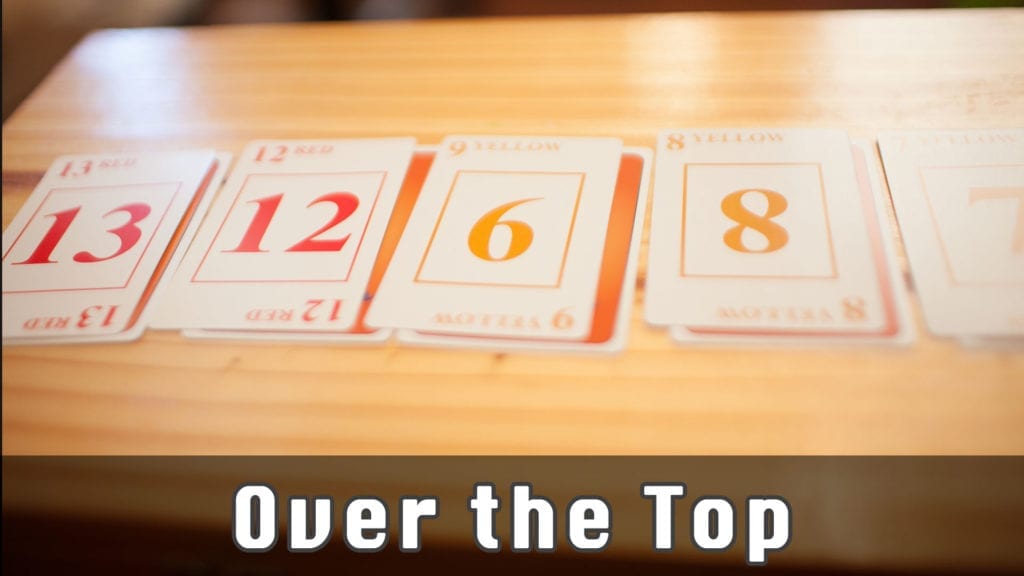
Over the Top
A game for 2
1. Remove all cards numbered 1, 2 and 3 of each color from deck, leaving 44 cards.
2. DEALING: To choose dealer, players draw for high card. The dealer shuffles the deck well and deals 10 cards each, face down, one at a time, alternately to opponent and self. Dealer then deals 10 cards each for opponent’s battery and dealer’s battery. The first 5 cards of each battery are dealt face down, side by side in a row, in front of each player. The next 5 cards are dealt face up on top of these cards, making 5 groups of 2 cards each. Thus each player begins the game with 10 cards in hand and battery of 10 cards, 5 of which are face up, and 5 camouflaged, covered up, face down. The 4 cards remaining are placed at the side of the table face down, as a nest.
3. BIDDING: Bid for the privilege of naming the trump color as in regular game. The dealer must begin by bidding 50 or over. High bidder names the trump color and then picks up the nest. He may exchange any of the cards in the nest for cards in the hand in order to strengthen his hand. He puts 4 cards back into the nest. No Count Cards-5’s, 10’s and 14’s- may be discarded or left in the nest. The nest is then removed from the table.
4. PLAY: Low bidder leads by playing a card from his own hand. High bidder follows. Opponent then plays any exposed card from his battery. High bidder follows by playing from his battery, completing a trick of 4 cards. The hand or battery capturing a trick leads for the next play. When a battery card takes a trick, that battery leads. Then the opposing battery plays, after which the owner of the first battery plays from his hand. Then the opponent does likewise. Note that one battery always plays immediately after the other, and one opponent plays from his hand after the other has done so.
A play from the battery is made only from the face up cards. As soon as an exposed card has been played from the battery, the card beneath it is turned face up ready to be used.
5. SCORING: 200 points win the game. Count Cards score as in regular game- each 14 counts 10, each 10 counts 10 and each 5 counts 5. Points captured by a player’s battery count as his own. If high bidder makes good his bid, both players score what they earn. If he fails to equal his bid, he receives no score, and his opponent’s score in that hand is doubled. Players may, if they wish, add 2 points for each captured trick.
6. All other rules are identical to regular game.
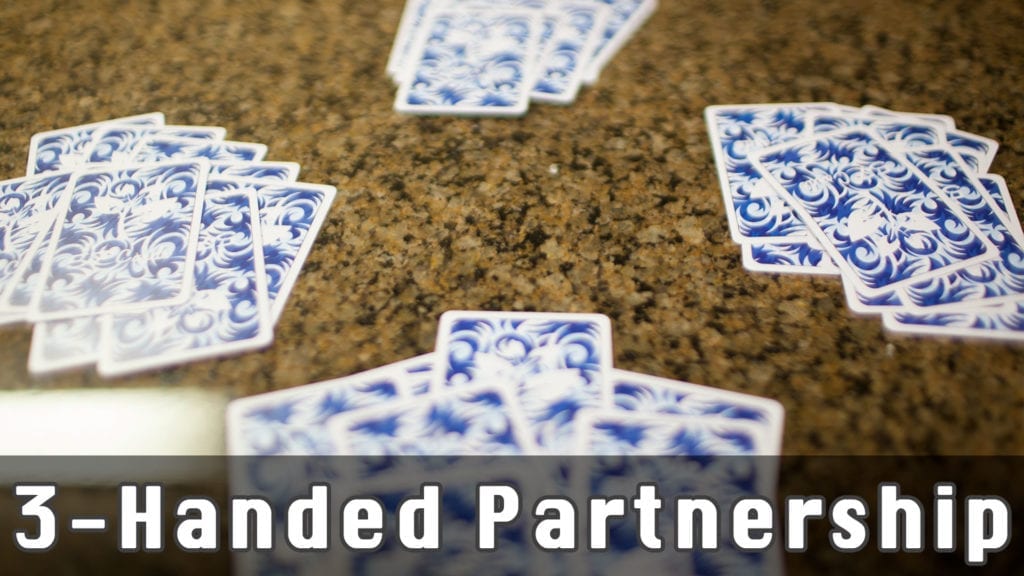
3-Handed Partnership
1. DEALING: To choose dealer, players draw for high card. Dealer shuffles deck and deals 4 hands of 14 cards each, as if 4 people were playing. One of these hands is therefore dealt to a dummy.
2. BIDDING: The 3 players bid for the privilege of naming the trump color as in regular game. Player at left of dealer must start with a bid of 40 or more.
High bidder always seats himself or changes places so as to sit opposite dummy, who becomes his partner for that hand. The 2 other players are his opposing partners.
3. PLAY: The player at the left of high bidder begins by leading any card he chooses. After this lead, dummy’s hand is displayed face up on the table in front of the imaginary 4th player, and arranged by color so that they may readily be seen. High bidder then plays a card from his dummy partner’s hand, and continues to play for dummy and for himself in turn, throughout that hand. When a card from dummy’s hand takes a trick, the next lead, of course, is made from dummy’s card.
4. SCORING: The score of each person is recorded. Partners in each hand score the total they have made together, as if each alone had captured all tricks. Each records identical score for that hand. High bidder is set back the amount of his bid if he fails to earn it. The pack is then redealt, and whoever becomes high bidder takes dummy as his partner for that hand. First player to reach or exceed 200 points wins the game.

Pounce with 57 Cards
Overview
Pounce is a card game for two or more players, but works best with no more than six. It is played like solitaire, with each player in command of his own deck of cards, but all building piles are shared between all players. To win, you will need fast hands, quick thinking, and more than a little luck.
Setup
To begin, each player must have his own deck of cards, and each deck must have a unique back design to it. Verify that all decks contain only the 1 through 14 cards, without the 57 card. Nominate one person to be scorekeeper; the scorekeeper needs only a pen and standard writing pad. Find a table large enough to seat all players, with plenty of room in the middle. Now each player must shuffle his deck and layout his cards into six piles according to the following rules: The first five piles are made as in Klondike solitaire, and the sixth pile is made by counting out thirteen cards from the top of the deck and laying them in a face up pile, in the same order as when they were in the deck.
The remaining cards will be used for stock. Then the scorekeeper will say “Ready … Go!” and play will begin.
How To Play
Play is like Klondike solitaire. The 1 card may be placed in the field (the table space bounded by all players’ layouts) to start build piles. Building on a build pile means placing the next higher card in rank of the same suit on top of the top card of the pile. So if the build pile’s top card is a 4 of Red, only a 5 of Red may be played on it. Within a player’s five piles, the top cards may be built upon in descending order, alternating red/yellow-black/green-red/yellow-black/green. When all face-up cards have been removed from one of the five piles, turn over the topmost face-down card. If there are no face down cards left in that pile, the top card of the pounce pile (a “pounce card”) or a 14 may be placed there.
Unlike in solitaire, in pounce players count off their stock in threes by palming the first card (face down), then the second card, then the third card, then laying them face up with the first card on top You can tell that you’re doing it right by the sound: “flip-flip-flip-thump”, etc. When the stock is all face up, pick it up and start again.
In each hand of pounce, the object is to get rid of your pounce pile. Pounce cards can be removed from the pile two ways: playing them on build piles and filling empty spaces in the five piles. Cards in the pounce pile may not be played directly on cards in the five piles. They may only be played on empty spaces.
When a player has removed the final card from his pounce pile, he says “Pounce!” and play immediately stops. Every other player must count the number of pounce cards he has. Scoring may then begin.
Special Rules:
If a build pile goes all the way up to 14, the player who played the 14 on the pile must say “Stop” and remove the pile from play. When the pile has been removed and everybody is ready again, the scorekeeper will signal to continue play.
The one-hand rule: No player may use both hands for building, either on build piles or the player’s five piles, at the same time. It is best to always keep your stock in one hand and use the other for building.
Pounce is generally a silent game during the actual gameplay. No player may intentionally vocally distract other players. This includes muttering to yourself.
If all players agree that they cannot build with their current configuration of cards, then play will stop, and each player will pull the bottom face-down card from the rightmost of their five piles that has face-down cards. Any player without any remaining face-down cards is out of luck. If the card does not play it is added to the bottom of the player’s stock.
At times two players will make a play for the same build pile at the same time. The one who makes the play first gets it, but the other player is not entitled to smash the victor’s fingers.
Scoring
As previously stated, when a player goes pounce, all other players must count the number of remaining pounce cards that they have. Each of these cards counts as -2 points against the player’s score.
After each player has made note of this, all build piles, complete and incomplete, are gathered, separated by owner, and giver back to each player. Players score 1 point for each card played on a build pile in that round.
(Note: it is standard practice to first count off the pounce card deduction (2x number of pounce cards left) from the scoring cards, set them aside, then count the remaining scoring cards. This remainder is the player’s score for the round.)
The scorekeeper then adds that score to the player’s previous score (or subtracts it, if the player has a negative score for the round). All decks are shuffled, new piles are laid out, and play begins again.
Winning
The first player to score 100 points is the winner!
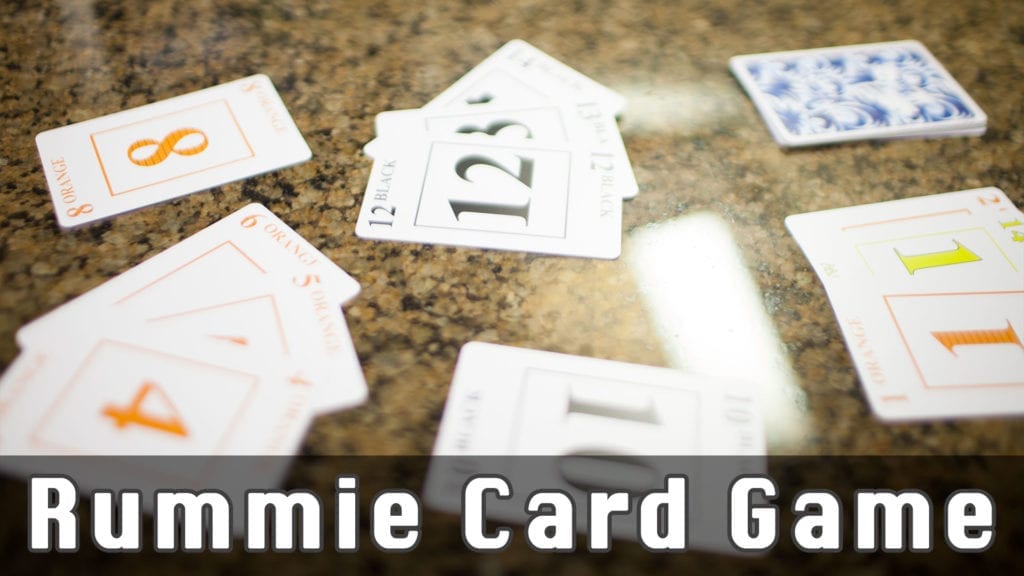
Rummy
The Deck
One deck of 56 cards is used. The wild 57th card is not used in this game. Cards in each color rank, from low to high:
1, 2, 3, 4, 5, 6, 7, 8, 9, 10, 11, 12, 13, 14
The Deal
The first dealer is chosen randomly, and the turn to deal alternates if there are two players, and rotates clockwise if there are more than two. In a two player game, each player is dealt a hand of ten cards. Seven cards each are dealt if there are three or four players, and when five or six play each player gets six cards. The cards are dealt one at a time, and after the deal, the next card is placed face up on the table to start the discard pile, and the remainder of the deck is placed face down beside it to form the stock. The players look at and sort their cards.
Object of the Game
The object of the game is to dispose of all the cards in your hand. There are three ways to get rid of cards: melding, laying off, and discarding.
- Melding is taking a combination of cards from your hand, and placing it face up in front of you on the table, where it stays. There are two kinds of combination which can be melded: sequences (also known as runs) and groups (also known as sets or books).
- a sequence or run consists of three or more cards of the same color in consecutive order, such as 4red,5red,6red or8red,9red,10red,11red.
- a group, set or book is three or four cards of the same rank, such as 7 red,7black,7yellow.
- Laying off is adding a card or cards from your hand to a meld already on the table. The cards added to a meld must make another valid meld. For example to the 4red,5red,6red you could add the 3red or the 7red . You are not permitted to rearrange the melds in the process. For example, 2red, 2black, 2yellow, 2green and 3black,4black,5black have been melded, you are not permitted to move the 2black from the group to the sequence, so as to lay off the 1black.
- Discarding is playing a card from your hand on top of the discard pile. You get rid of one card this way at the end of each turn.
- 57 Wild Card is not used in the game of rummy. Instead, see gin rummy with 57 cards for a slightly different game that includes this wild card strategy.
Play
If there are two players, they take alternate turns starting with the non dealer. If there are more than two players, they take turns in clockwise rotation, beginning with the player to dealer’s left.
Each turn consists of the following parts:
- The Draw. You must begin by taking one card from either the top of the Stock pile or the top card on the discard pile, and adding it to your hand. The discard pile is face up, so you can see in advance what you are getting. The stock is face down, so if you choose to draw from the stock you do not see the card until after you have committed yourself to take it. If you draw from the stock, you add the card to your hand without showing it to the other players.
- Melding. If you have a valid group or sequence in your hand, you may lay one such combination face up on the table in front of you. You cannot meld more than one combination in a turn. Melding is optional; you are not obliged to meld just because you can.
- Laying off. This is also optional. If you wish, you may add cards to groups or sequences previously melded by yourself or others. There is no limit to the number of cards a player may lay off in one turn.
- The Discard At the end of your turn, one card must be discarded from your hand and placed on top of the discard pile face up. If you began your turn by picking up the top card of the discard pile you are not allowed to end that turn by discarding the same card, leaving the pile unchanged – you must discard a different card. You may however pick up the discard on one turn and discard that same card at a later turn. If you draw a card from the stock, it can be discarded on the same turn if you wish.
If the stock pile has run out and the next player does not want to take the discard, the discard pile is turned over, without shuffling, to form a new stock, and play continues.
A player wins an individual hand by either melding, laying off, or discarding all of his or her cards. Getting rid of your last card in one of these ways is called going out. As soon as someone goes out, play ceases. There can be no further melding or laying off, even if the other players have valid combinations in their hands.
Scoring
When a player goes out, the other players add up the value of all the cards still remaining in their hands, as follows:
- All cards are worth the number value displayed on the card. 10s are worth 10 points while 14s are worth 14 points.
- Ones are worth 1 point each
The total value of all the cards in the hands of the other players is added to the winner’s cumulative score.
The game continues with further deals until a player reaches the points target that was decided before the game began, or until the agreed number of deals has been played.
Optional House Rules.
These optional rules should be discussed and decided by the players before the beginning of the first deal.
Multiple Melds
- Some people play that you can lay down as many melds as you desire in each turn.
- Most people allow a player who has not previously melded or laid off any cards to earn a special bonus if they can go out in a single turn by melding or laying off their entire hand. This is called going rummy, and the score for the hand is doubled, or in some versions the winner gets a bonus of 10 points.
Laying off
Some play that you may not lay off any cards on other players’ melds until you have laid down at least one meld of your own.
Ones High or Low
In the standard game, ones are low. 1-2-3 is a valid run but 13-14-1 is not. However, some play that ones can be counted as high or low, so that 13-14-1 is also a valid run. When playing with this rule, ones are given the higher value of 15 points instead of 1 point, reflecting their greater usefulness.
A few players go further and allow “round the corner” runs with an ace in the middle (14-1-2), but this is unusual.
Last discard
Some people play that in order to go out, you must end your turn by discarding your last card. You are not allowed to meld all your cards, leaving nothing to discard.
End of the Stock
Some play that when the stock has run out and the next player does not want the discard, the discard pile is shuffled before resuing it as a stock. This is the version now given in most books. If there is no shuffle, players who can memorise the order of cards in the discard pile will clearly have an advantage.
It is just about possible, though very unlikely, that a repetitive situation could occur where each player is holding on to cards wanted by the others. Each player draws from the stock and discards the card they just drew. In this case, recycling the discard pile as a new stock, whether shuffled or not, will not help. If the players are stubborn, the game could be endless. To avoid this, it may be a good idea to limit the number of times that the discard pile can be reused as a new stock. I suggest that after the stock becomes exhausted for the third time, the play should end if the next player does not want to take the discard. Alternatively, you could agree that the discard pile gets reused only once and the play ends when the stock is used up for the second time.
In the version known as Block Rummy, the discard pile is not reused at all. If the stock has run out and the next player does not want to take the discard, the game ends at that point. Everyone scores the value of the cards remaining in their hands.
If the game ends without anyone going out, all players count the value of the cards remaining in their hands. The winner is the player with least points, and scores the sum of the differences between this and the points in each other player’s hand. Example: A has 6; B has 15; C has 7; D has 21. A is the winner and scores 25 = (9 + 1 + 15). If two or more players tie for lowest, they share the winnings equally.
Players are allowed, at their turn, to count the number of cards remaining in the face down stock if they wish. As a courtesy (to save others having to count as well), a player who counts the stock should correctly announce to the other players how many stock cards remain.
Scoring
Some play that instead of the winner scoring points, each of the losers score penalty points according to the cards left in their hand. If the game ends without a winner then everyone scores their cards as penalty points. When someone reaches 100 or more, the player with the lowest score wins.
Some play that each loser pays the winner according to the number of points in their hand (or the difference between their score and the winner’s score if no one went out). This method is appropriate when playing for money. The session would last for a set number of hands rather than be played to a target score.
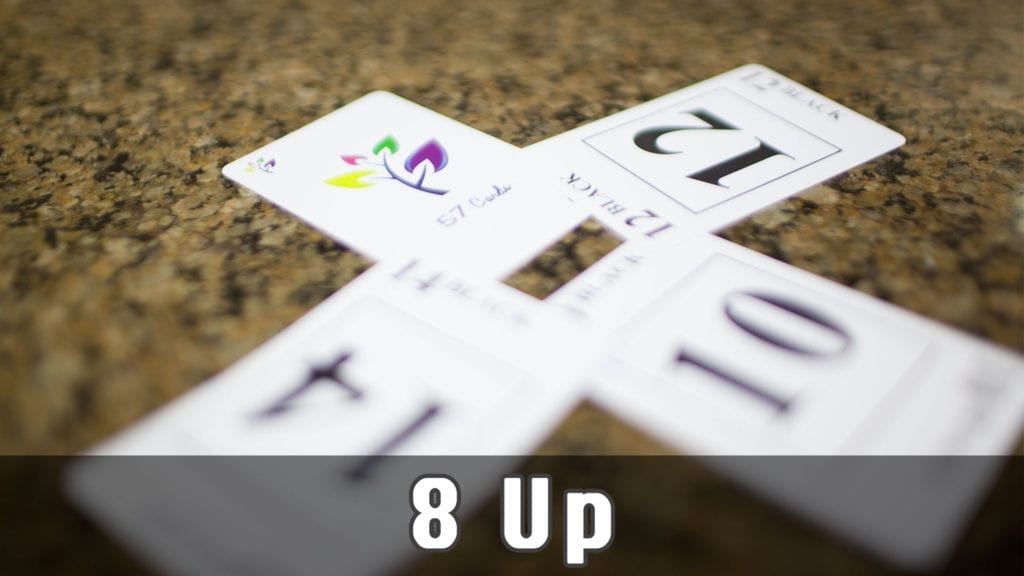
8-Up
Amount of Cards per Round
- 8 Cards
- 7 Cards
- 6 Cards
- 5 Cards
- 4 Cards
- 3 Cards
- 2 Cards
- 1 Card
- 1 Card. Note: This should be done “Indian style” by placing the card on your forehead without looking at it so you can see all of the other players cards, but do not know what card you have. You then bid accordingly.
- 2 cards
- 3 Cards
- 4 Cards
- 5 Cards
- 6 Cards
- 7 Cards
- 8 Cards
Bidding
After all the players are dealt their cards for the round, one card is flipped over from the top of the deck. The color of the card is then trump for this round (if the wild 57th card is flipped, pick the next card). Players then look at their hand and based on knowing the trump color, the amount of tricks possible, and the amount of players, the then decide on how many tricks they will likely win for the round. All players put out their hands and on the count of 3 put out the number of fingers representing the amount of tricks they will take in the round.
Players who at the end of the round make their bid are awarded a bonus of 5 points. Each trick taken is worth a point.
Winning
Each round totals are added per player until all rounds have been played. The payer with the most points at the end of all 16 rounds wins.
Example Scenario
- Player bids 3 for the round
- Players gets 3 tricks at the end of the round
- Player is awarded 8 points
Example Scenario 2
- Player bids 3 for the round
- Player gets 2 tricks at the end of the round
- Player is award 2 points for the round
Example Scenario 3
- Player bids 3 for the round
- Player gets 4 tricks at the end of the round
- Player is awarded 4 points for the round.
Example scenario 4
- Player bids 0 for the round
- Player gets 0 at the end of the round
- Player is awarded 5 points for the round.
In some areas 8-up is called “Up the River, Down the River” for obvious reasons. You go up the river from 8 cards to 1 card dealt, then down the river from 1 card to 8 cards dealt. My understanding is that the rules are still the same as described above.

On-Off Rook [Rook-on, Rook-off] [On-off 57]
Equipment—Rook-On Rook-Off Game Board, 2 Decks of 57 Playing Cards, 2 boxes of poker chips(100 count), and also an even number of players.
Object of the game—For your team to be the first to get 3 sets of 5 chips in a row.
How to play—
Deal out 5 cards to each player. Every other person is on a team. Team 1
takes blue chips and Team 2 takes red chips. The white chips are used when you get 5 chips of the same color in a straight line, you then cap that row. If your row comes out of a corner square you only need 4 chips to get your row of 5 because the corner counts as if it already has a chip.
Both teams can use the same corner at the same time. Rows can be straight or diagonal.
When a color has 2 capped rows intersecting, the third set cannot use any of the chips in those two capped rows. In other words you can intersect your rows only one time. A card with 11 (any color) can put a chip on where ever you desire. A card with 12 (any color) can take any chip off the board. The Wild card acts as an 11 or 12.
Starting the Game—(for example)
Player one lays down a card with a green four and places a blue chip on the green four square. Player one draws a card off of the draw pile.
Player two lays down a red 10 card and places the red chip on the red 10 square and draws a card off the draw pile, and so on… Players draw a card after the chip is laid each turn. If a player forgets to draw a card and the next player has taken his turn he loses his chance to draw a card and thus plays with four cards.
Happy Playing!
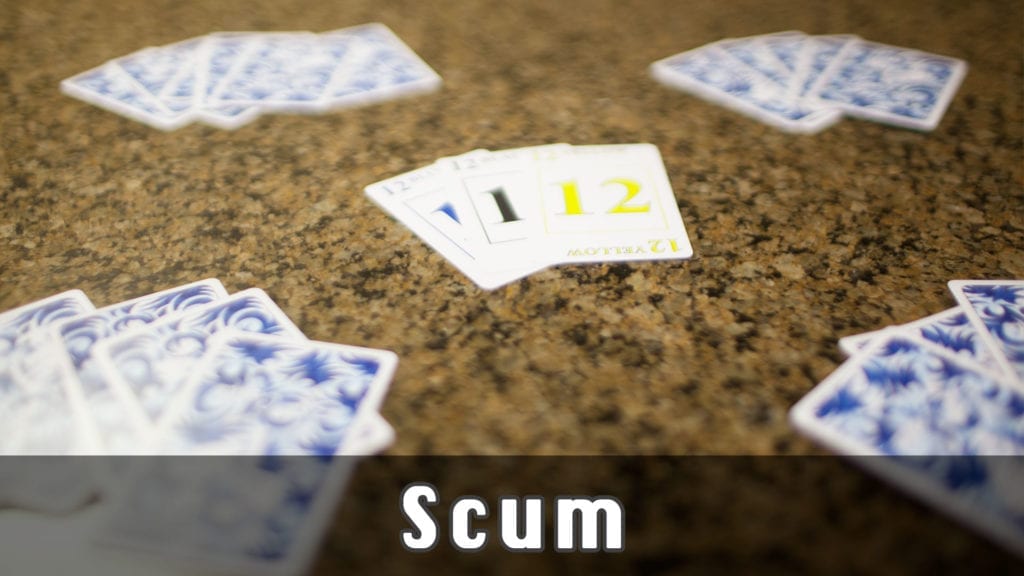
Scum
Scum works best for four players, but it is possible to play with more. For reasons that will become clear later, you will need at least four to play.
Scum can be played with pretty much any deck of cards that has a definite heirarchy (i.e., 14 is highest, then 13, then 12, and so on down to 1) and one wild card (57 Card).
There are four positions that the players will fill while playing Scum. They are, in descending order of importance and desirability: President, Manager, Worker, and Scum. The object of the game is to rise above your fellow players to become President. Once you have reached that position, your object is to stay there.
A word is in order now about the poor schmuck…er, the player who is Scum. This player is responsible for all the dirty work in the game. Scum has to shuffle and deal the cards between games, and also has to pick up the cards between tricks. In addition, Scum is most likely going to be the target of a lot of abuse during the course of play. So why play? Because, to rephrase the Law of Conservation of Angular Momentum, what goes around comes around. The player who is Scum this game may be President next time around, and vice versa.
The object of each round is to be the first player to get rid of all their cards. This player then becomes President for the next round. The next player to get rid of all their cards is Manager, and the next is Worker. The last one still holding cards–you guessed it–is Scum.
Before the game starts, it will be necessary to determine who will fill what positions for the first trick. How you do this is entirely your prerogative. We usually draw cards at random from the deck, with the higest being President and the lowest being Scum. You can also determine the opening positions alphabetically, by height, by arm wrestling, by Rock-Paper-Scissors, or by any other method you choose. Once the opening roles are determined, the players should sit in a circle–preferably around a table of some sort–in descending order. This will place Scum and President next to each other, by the way. (If possible, try to enhance the mood by having chairs appropriate to each position, such as a La-Z-Boy recliner for the Prez, one of those intolerable metal folding chairs for Scum, and that sort of thing.)
The round begins when all players are seated and all the cards are dealt. In dealing the cards, Scum first deals to Worker, then to himself, then to President, then to Manager, and so on, until all the cards are dealt. The observant reader will note that this means Worker and Scum already have one more card to get rid of than President and Manager. But wait, there’s more.
The heirarchy of cards is as follows: 57 Wild Card is highest, followed by 14, 13, 12, 11, 10, 9, 8, 7, 6, 5, 4, 3, 2, and 1 as the lowest. I thought I’d mention this now, because after the cards are dealt, Worker has to give the highest card in his hand to Manager. That’s right, the highest card, no questions asked. Manager then gives one card she doesn’t want (not necessarily the lowest, mind you) to Worker. Now, Scum, before you laugh, you should know have to do the same with President, except you have to give him your two highest cards, and you’ll get back two cards the President didn’t want.
Now game play begins. The President leads on the first trick; after that, the last player to play on the previous trick leads. The leader will play one or more cards. The next player in line must then beat that play. This is done by playing a higher card or combination of cards. Matching is not enough; a player must play something higher.That is to say, you can’t play a 5 if the player before you played a 5. You must play a 6 or higher. The same applies with pairs, triples, and four-of-a-kinds. If that player cannot beat the play, they pass to the next player. They may also pass if they feel it is to their strategic advantage to do so. When all four players have had had a chance to play, the trick is over, and Scum clears the table. The last player to lay down a card (or cards) leads the next trick.
It is important to note that a player must always play the same number of cards as the player before him. For example, if one player lays down a 6, the next player must lay down a 7 or higher. If the player lays down three 4’s, the next player must lay down three 5’s or higher. A single must be beaten with a higher single, a pair with a higher pair, and so on. The only exception is that a single Joker will beat any other play. A Joker will, for instance, beat four Aces. Consequently, when a Joker is played, the trick is over. Players must stick to ‘sets’; that is to say, a player can never lay down more than one card with different values. For instance, a player cannot lay down a 5 and a 7 to try to beat a pair of 4’s. Any player who attempts to do this should be treated like Scum.
Here is a description of a couple of tricks, just to help you get the concepts down:
1. President opens the game by playing a 6. Manager follows by playing an 8. Worker plays a 9, and Scum plays an 11. Scum then cleans up the cards before the others start taunting him.
2. Scum leads off the next trick with three 6’s. President passes, having no triples. Manager has three 11s but wants to save them for later in the game; she also passes. Worker plays three 9’s. Scum is a little slow getting the trick cleared, and Manager says, “Pick it up, Scum!”
3. Worker plays a pair or 8’s. Scum follows with a pair of Queens. President, who has a hand full of singles and is sick of all the multiples being played, throws down the 57 Wild Card. Manager silently laments the pair of Kings she can’t play this trick. Scum cleans up the cards, and President will lead the next trick.
Well, that’s that. Now go get a few friends who won’t mind a little abuse, and have fun.
Note: Scum can also be played by having a continuous flow of play. Meaning, a round does not officially end until all players have passed. Therefore, the last player to play will get lead and you can choose to keep playing higher and higher in each round that is started.
Note 2: Another version of scum can including more wild cards. For example, you may want to try and have all the 1s wild as well as the 57 card. That creates a bit more of a wild card frenzy.

BS
Set Up
To set up the game you deal a no wild 57 Card deck out (removing the 57th Card) equally to everyone that is playing. Do not worry if one or more players have more cards then another.
Play
The first player discards 1s face down into the middle of the table, the next player discards 2s face down, then 3s, 4s, … And so on until you get to 14s and then you go back to 1s.
When it is your turn you can put down as many cards face down as you would like as long as they are the right number. So if you are on 7s you can put three 7s face down and say “3 Sevens”. But what if you are on 7s and you don’t have any, hmmmm.
Since you are throwing cards face down you do not need actually throw away a 7. You can put a 6 and a 4 face down and call “2 Sevens”, as long as no one says anything your good.
But if you or someone else suspects someone of cheating you can say, “BS” or “I doubt it” or “cheat” and the other player has to flip over the cards they just threw down. If you were right and they were cheating they must pick up the entire deck of cards.
But if you where wrong and they actually threw away what they said then you have to pick up the cards.
Winning the BS game
The first person to get rid of their cards is the winner.
Tip
When you cheat make it small. No one will expect you of cheating if you only discard 1 or 2 cards.
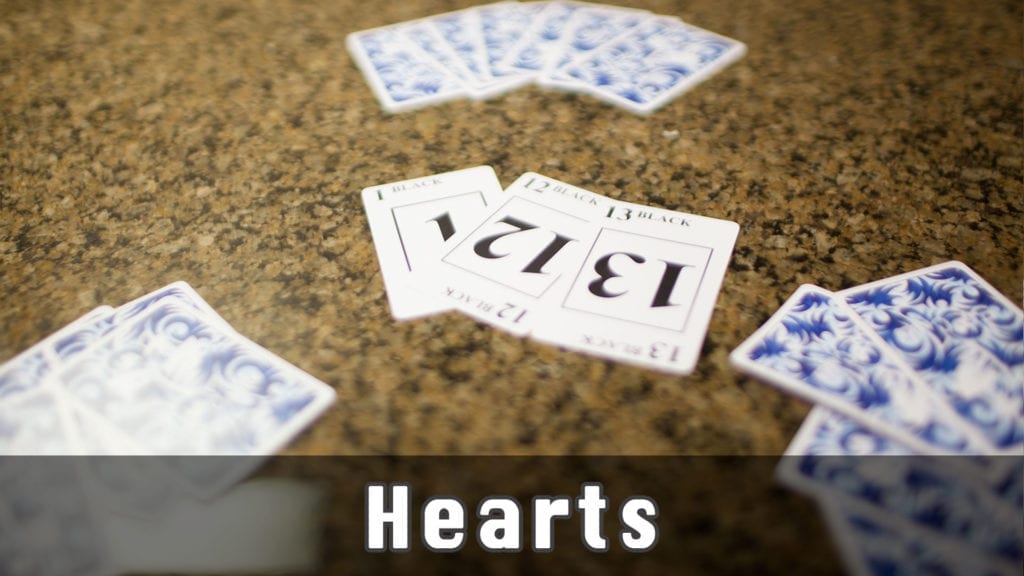
Hearts with 57 Cards
Setting it up
You set the game up by dealing clockwise until all of the cards are used up. Deal so that all players have the same amount of cards using all the cards available. Any remaining cards are left to the side to be taken by the last trick.
Passing Cards
You can also pass 3 cards face down to other players. The dealer should call out how many cards to pass and what direction while dealing out the deck of cards.
Playing, 57 card hearts card game rules
Whoever has the 2 of green goes first. The first person plays 1 card of 1 color; all other players must play a card of the same color if possible. If you don’t have a card from that color you can play any other card from your hand.
Whoever has the highest card of the starting color wins that point and gets to lead the next hand.
You cannot play a Red unless either a Red has been played before or you have nothing but red in your hand.
Winning
In this game getting points is bad. Each red that is played is 1 point and the 57th card is 14 points.
The game continues until 1 player has 100 points or more. When that happens whoever has the least amount of points wins.
Shooting the Moon
A player may shoot the moon by collecting all the point cards in their hand during one round. That would mean winning all of the 14 red cards as well as the 14 pt 57th card. This then gives 28 points to all of the other players and the individual shooting the moon receives 0 pts for the round.
Golden Ten
Another version of Hearts played with 56 cards has been called golden ten. The rules for this version are as follows:
This is a game for 3 to 7 players, related to Hearts, played with a Rook deck of 56 cards. The cards are of four colors: red, yellow, green and black. In each color there are cards numbered from 14 (high) to 1 (low). The aim is to avoid wnning tricks containing red cards (especially the 5 and 10), while trying to win the trick containing the yellow 10 if you can.
Deal and play are clockwise. The dealer deals out the cards, one at a time, as far as they will go so that each player has equally many. With 3, 5 or 6 players there will be one or two cards left over; these are taken by the winner of the first trick.
The player to dealer’s left leads to the first trick. When playing to a trick you must if possible play a card of the same color as the led card. If you have no cards of this color you may play any card. Whoever plays the highest card of the color that was led wins the trick and leads to the next.
When all the cards have been played each player counts the value of the cards in their tricks. Each red card in your tricks counts 1 point against you, except for the five which counts 5 against you and the ten which counts 10 against you. The 10 of yellow is called the Golden Ten and it reduces your red card penalties by 10 points; if you had fewer than 10 red penalty points, the Golden 10 reduces them to zero.
A game consists of six deals, the turn to deal passing to the left after each hand. The player with the lowest cumulative score of penalty points wins the game.

